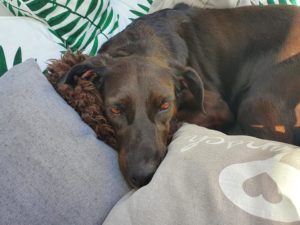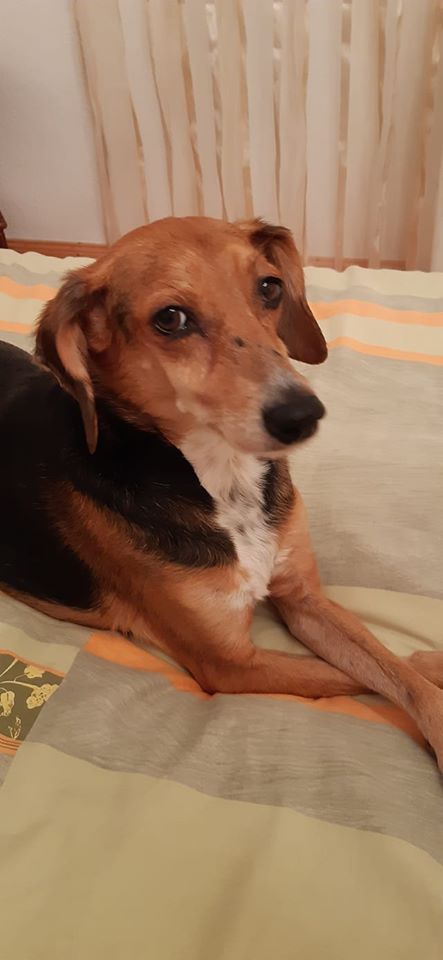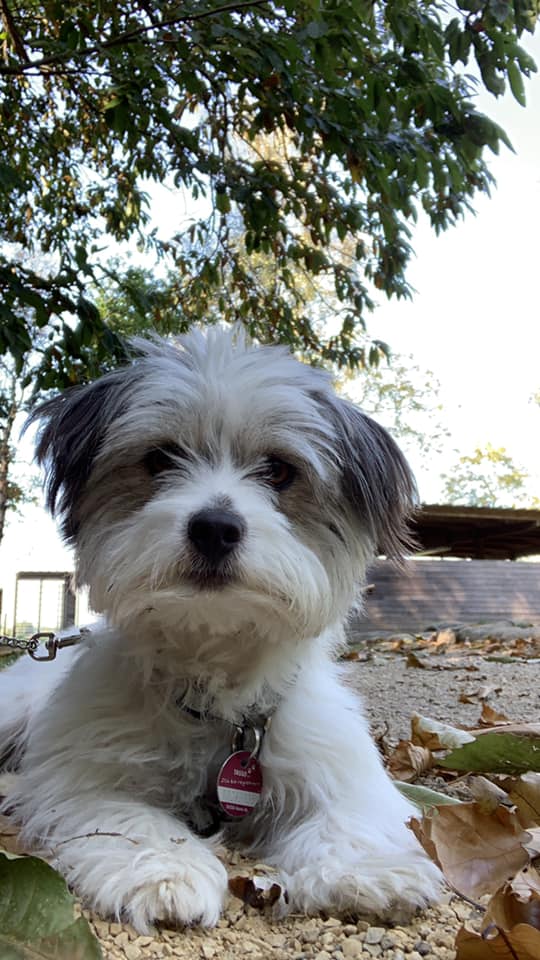Leishmaniosis
What is Leishmaniosis?
If you are interested in a dog which was diagnosed Leishmaniosis, don’t click away before you are well informed. Consider that these dogs have great difficulties finding a home. They really need a chance. Maybe, after you read all the information, you decide that it’s ok for you to choose a dog with leishmaniosis.

Yuri with leishmania, 2019, in the shelter. His treatment just had started.


Yuri with his new friend in his new home in England, August 2020. A happy dog and a happy family!
Leishmaniosis is a parasitic disease that is found in parts of the tropics, subtropics, and southern Europe. It is classified as a Neglected Tropical Disease (NTD).
Leishmaniosis is caused by infection with Leishmania parasites, which are spread by the bite of phlebotomine sand flies. The sand flies that transmit the parasite are only about one third the size of typical mosquitoes or even smaller.
There are two types of leishmaniosis seen in dogs: visceral and cutaneous. Each type affect different parts of the dog’s body.
Not every patient has all symptoms!
a. Visceral (affects organs of the abdominal cavity):
possible symptoms:
Severe weight loss
Loss of appetite (anorexia)
Diarrhea
Tarry feces (less common)
Vomiting
Nose bleed
Exercise intolerance
b. Cutaneous (affects the skin) :
possible symptoms:
Hyperkeratosis
(most prominent finding; excessive epidermal scaling with thickening,
depigmentation (loss of skin color), and chapping
of the muzzle and footpads)
Alopecia — dry, brittle hair coat with symmetrical hair loss
Nodules usually develop on the skin surface
Intradermal nodules and ulcers may be seen
Abnormally long or brittle nails are a specific finding in some patients
Other signs and symptoms associated with leishmaniosis can include:
Lymphadenopathy —
disease of the lymph nodes with skin lesions in 90 percent of cases
Emaciation
Signs of renal failure — excessive urination, excessive thirst, vomiting
Neuralgia — painful disorder of the nerves
Pain in the joints
Inflammation of the muscles
Osteolytic lesions — a “punched-out” area with severe bone loss
Inflammation of the covering of bones; rare
Fever with an enlarged spleed (in about one-third of patients)
Currently, no cure exists for canine leishmaniosis, but various treatment options are available in different countries. Treatment is best coordinated with veterinary research hospitals. Treatment does vary by geographic area, strain of infection and exhibited symptoms.
Dogs can be asymptomatic for up to 7 years.
Most common treatments include:
L. donovani
Antimonial resistant
Polyene antibiotic amphotericin B
L. infantum[23]Amphotericin B
Meglumine antimoniate
Pentavalent antimonials
Miltefosine
Allopurinol
There have been no documented cases of leishmaniosis transmission from dogs to humans!

This is Enca. Her new family writes: Das ist Enca, hier vom Souda Shelter. Sie ist so eine liebevolle, soziale Hündin.Verträgt sich auch auf Anhieb mit unseren zwei Stubentiger. Wir betreuen es nicht, einer LM Hündin eine Chance gegeben zu haben und sind glücklich, dass Enca bei uns ist. ..wir freuen uns auf viele gemeinsame Jahre mit ihr. Vielen lieben Dank an The Souda Shelter Projekt für die zügige Vermittlung unserer Enca. Ein LM Hund hat es verdient adoptiert zu werden…auch wenn es bei der Ernährung und der Pflege etwas mehr Arbeit ist…Liebe Grüße von Karlsruhe/Germany nach Kreta….
What does it mean if I adopt a dog which already has leishmaniosis?
Only a dog, which was effectively treated, is now feeling well and gets its daily treatment, appears in the category “Dogs for Adoption”.
Leishmaniosis can be treated but not cured. The animal usually is stuck with the parasite for the rest of its life but it is kept dormant. Cost for the therapy is approximately 4 to 8 Euro a month for a pack of Allopurinol.
The animal can live a full live when treated!
Before leaving every(!) animal gets tested and if positive a titer. This tells you how active the leishmaniosis is at the moment.
In some serious cases the dog can have misfunctions of the kidney or liver and needs an additional treatment.
At home apart from the daily pill an animal should have its antibodies tested regularly. Healthy food and appropriate exercise help the dog’s immune system. A flare-up of the disease is still possible and needs further treatment.
Leishmaniosis is only transmitted by the sand fly and can’t be directly transmitted to another dog, f.e. by a bite. Also a transmission to a human has never been reported.
The sand fly can’t survive in Northern Europe. If – through climate change – it may move North one day, it will do so with the help of rodents, deer and other animals. A well cared for and treated dog won’t be the problem.
If you have fallen in love with a dog which was already treated for leishmaniosis, we can give you more specific information regarding this dog because every animal reacts differently to the disease.
Yes, there will be more costs but if that is ok with you, don’t let leishmaniosis come between you and the dog of your dreams!
- Links for further reading:
LeishVet (in English, see download for guidelines, good!)
Living With Leish (in English)
Leishmaniose beim Hund behandeln und vorbeugen (in German)
Leishmaniose – ein zahnloses Schreckgespenst (in German)
Don’t think a purebred dog grants a long lifespan!
Owners of dogs with leishmaniosis tell their stories:
Amylynn:
My pup was misdiagnosed so the lesh was untreated for a while. He had to stay on medication. Super cheap and easy to find. I took him back to the U.S. with no problems.
Karin:
Ich habe die Rasha diesen Sommer 2019 aus dem Souda Shelter adoptiert. Sie ist Leishmaniose positiv. Sie hat stellenweise etwas dünnes Fell, wer es nicht weiss, bemerkt es aber nicht. Die Schleimhäute sind oft gereizt, etwas Nasenausfluss beobachte ich aber es hält sich in Grenzen. Zeitweise tritt Durchfall auf. Das hat auch mit der Erkrankung zu tun. Mit Haferschleim, frisch gekochtem Huhn und Magerquark oder Hüttenkäse habe ich es zur Zeit gut im Griff. Rasha bekommt zudem 1x täglich (morgens) 300 mg Allopurinol. Das ist in Deutschland verschreibungspflichtig und ich beziehe es über meinen Tierarzt oder mit Rezept. Sonst ist die griechische Göttin fit .

Karin: Egal wie alt oder welche Vorerkrankung, mit Beobachtung und Hilfe vom Tierarzt oder alternativ haben die adoptierten Fellnasen viel Freude und ein schönes Leben.
Pam:
Wir haben Bounty nun gut ein Jahr, sie hat Leishmaniose und das wussten wir vorher. Sie ist dennoch hier eingezogen und ich habe es nicht einmal bereut- unser Leben ist so viel reicher mit ihr.
Es war keine leichtfertige Entscheidung, Leishmaniose ist nicht heilbar.
Man sollte sich vorher gut informieren und am Wichtigsten: man braucht unbedingt einen Tierarzt, der sich mit Leishmaniose wirklich auskennt.
Alle 3 Monate steht eine Blutuntersuchung an und sie muss 2x täglich Tabletten nehmen. Sie darf wegen dieser Tabletten nicht alles fressen.
Auch gibt es gute Facebook-Gruppen zu diesem Thema, die hilfreich sind bei alltäglichen Fragen, wie zum Beispiel beim Futterthema.
Bountys Werte werden jedes Mal besser, vielleicht können wir die Tabletten bald absetzen.
Sie ist fit, freundlich, aktiv und ein Goldschatz von einem Hund, den ich nie mehr missen möchte.
Letztendlich muss man sich aber darüber im Klaren sein, dass Leishmaniose keine leichte Krankheit sein kann, wenn sie aktiv ist und sich in verschiedenen Krankheitsbildern zeigen kann.
Wir haben den perfekten Tierarzt für sie und es geht ihr gut.
Ich würde nicht dringend jemandem raten, einen Leishmaniosehund zu adoptieren, aber ich würde dazu raten, den Hund einziehen zu lassen, in den man sich verliebt – auch wenn er Leishmaniose hat.

Deb:
We adopted Lucy, and blood tests were positive for Leishmaniosis. She was treated with Milteforan, and after this tested negative, which she has in the two tests since. If she had still been positive she would have had to take a tablet a day, but they are really cheap (a few euros a month). I was devastated when she tested positive, but the vets were very reassuring. Lucy was very fortunate, to be totally cured. Now I know more about it I would adopt a dog, knowing that it had Leish.

Laura:
I adopted a Leish positive dog from Greece in the summer of 2017. She was older and unfortunately had kidney insufficiency. We were fortunate enough to have found an experienced vet, who was honest about the prognosis regarding the imminent kidney failure. We had 227 days together and when she relapsed, I decided to let her go, she wasn’t responding to the Milteforan and Glucantime was already out of the question.
I adopted Charlie Leish negative and decided to have him covered via health insurance, just in case.
Overall, I would adopt a dog regardless of Leish but one has to be well prepared. Sadly, being a volunteer homechecker for other rescues, there are many that do not inform prospective adopters about the possibility of Leish nor do they recommend regular testing.
Elisabeth adds to Laura’s comment:
To send an animal to a new home, locally or abroad without the animal being tested is irresponsible. It puts the health of the animal in jeopardy and also is unfair to the owner to have to later deal with the ‘unexpected’ circumstances.
Kiia:
My Charlie is leishmania positive, he takes two tablets of Zyloric daily. When I first saw Charlie at the shelter I thought this dog wouldn’t live long. That was in 2015. After he started getting his medicine properly he made a huge progress. The whole dog changed. Now, in 2019, Charlie lives happily in Finland. He is also diagnosed with a heart condition. That medicine is quite expensive but the zyloric for leish is not. Its about 25€/100 tablets. There is no other difference to leish free dogs other than nail growth (in my case)
Last time he got his leish levels checked (in Crete) they were so low that it was almost like he was leish free. Of course he is not and will never be but it was great news.
Leishmania doesn’t bother me one bit and I really hope that people will not see it as bad as they do at the moment. A vet here in Finland freaked out so badly about it that she already started talking about putting Charlie down, I was furious. The next one I went to see laughed and told me to just ignore it. But yeah, since it cannot spread here (Finland) theres no reason to worry about it and cause panic. Even while living in Crete and I had Charlie and my other dog I was not too worried. We just made sure to keep the dogs inside of the house during the night. I refused to use the collar after it burned my other dog.
My Charlie ❤️ so glad I have him. And I would definitely adopt another leish dog if my financial situation was a bit better ?

Alison:
My Eric is Leishmaniasis positive …once you get around the basic understanding it becomes easier…we’ve been dealing with it for over 6 years with only one relapse in that time…which wasn’t even definite but we treated for it anyway. Eric is also med free for 18 months so it is manageable. Not everyone has the same experience but for me it isn’t a deal breaker. Costs vary depending where you live … level monitoring tests need to be done every 6 months to keep an eye on whats going on…but we’re on such a plateau we’re on yearly bloods. Again it differs vastly. It’s something that needs to be considered when adopting because you have to be completely on board and committed with it, but would it stop me adopting?…hell no…I adopted my boy, not Leish…we just deal with it.

Susanne: Here is lovely Tanja, from Animal Sos in Spain. Her level was very low. In the beginning she ate her purinol and at that time it was not so easy to get the medicin and it was rather expensive. She did not eat any medicine the most time in her life. She was total healthy all her life, this picture is in the last time in her life. She was a lovely friend we all miss very much. She was nearly 15 years. ❤ I should absolutely take another dog with sandfly, but I must know before.

